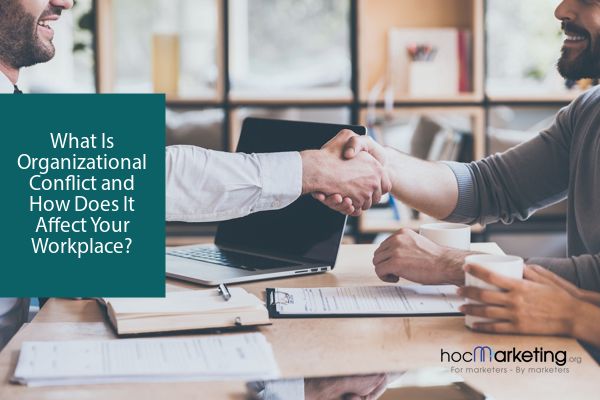
What Is Organizational Conflict and How Does It Affect Your Workplace?

Organizational conflict is a state of disagreement among individuals or groups in a workplace It can arise due to various reasons such as competition for resources, jurisdictional ambiguity, status struggles, etc However, if managed effectively, conflict can lead to positive outcomes and growth for an organization
Organizational conflict arises from a situation where people working in an organization perceive or experience opposition in their interests, values, or needs, leading to disagreements. These disagreements can result in hostility between authority and the affected individuals or even between colleagues.
In a workplace setting, organizational conflict can manifest in various ways and revolve around different issues such as working hours, task delegation, revenue sharing, and even disagreements between union and management or among departments and individuals. Moreover, conflicts can also take on more subtle forms such as role ambiguity, feelings of jealousy or rivalry, and power struggles.
Conflicts within a company can arise due to various factors, and it is crucial to address them in a constructive manner. Employing a logical approach that involves examining the problem, exploring options, hearing out all parties and working together to find solutions can lead to a positive outcome.
Types of organizational conflict
The various types of organizational conflict are as follows
1. Inter-personal conflict
Inter-personal conflict is a fundamental type of organizational conflict that arises from disparities in personal background, work-style, and personality between two colleagues. The primary reasons behind such conflicts are varied and can be attributed to several sources.
A. Lack of information
This type of organizational conflict occurs because of the break-down in communication between two or more individuals in an organization
B. Personal differences
This type of organizational conflict arises because of the differences in family background, traditions, values, experience, education, culture and upbringing.
. However, if not addressed properly, it can lead to long-term negative effects on the organization and its employees. It is important for management to identify the root causes of environmental stress and take appropriate measures to address them. This can involve providing additional resources, implementing strategic changes or offering support to employees who are struggling. By effectively managing environmental stress, organizations can create a more positive and productive work environment for all employees.
D. Role incompatibility
This type of organizational conflict occurs because of the differences or incompatibility between an individual and his manager
2. Intra-personal conflict
Intra-personal conflict refers to the internal struggle that an individual experiences due to a mismatch between their personal vision and objectives and those of the organization. This type of conflict can be categorized into three different types.
When an individual's pursuit of one goal prevents them from achieving another, it results in goal conflict. This phenomenon is intricate as it involves balancing the positive and negative aspects of multiple competing goals that cause conflict.
The three types of goal conflict are
B. Approach-approach conflict
This goal conflict occurs when the individual approaches two or more than two mutually exclusive and positive goals
Approach-avoidance conflict –
The individual is faced with a difficult decision as they are motivated to avoid each goal, but at the same time, they must also choose one to pursue. This type of conflict arises when the goals have negative consequences or outcomes, leading to a sense of goal conflict.
C. Role conflict
This type of organizational conflict occurs when an individual tries to play several roles but does not have the time and resources to do so.
Role conflict can occur between the expectation of the role and the personality of a person
Role conflict can occur because of contradictory expectation about how the role should be played
. As a result, the individual becomes frustrated and may lash out in conflict towards others or towards themselves. This can manifest in a variety of ways, including passive-aggressiveness, anger, or self-destructive behavior. It is important for individuals to recognize when they are feeling frustrated and to find healthy ways to cope with their emotions in order to avoid escalating the conflict.
Fragment 18: The internal barrier includes disabilities, low intelligence, lack of skill or personal limitations which can put a roadblock on the aspirations of an individual.
Rewritten: Individuals may face internal barriers such as disabilities, low intelligence, lack of skills, or personal limitations that can impede their aspirations.
The defence mechanism adopted by individuals include compromise, fixation, withdrawal and aggression
3. Intra-group conflict
This type of organizational conflict occurs when an individual has to work in a group and is unwilling to match the group dynamics. This leads to his exclusion from the group
4. Task interdependence
5.Competition for resources
Interdependence conflict is a situation where two groups within an organization rely on each other for either mutual benefits or in a one-way direction. This type of conflict can escalate quickly due to the differences in priorities and objectives between the groups involved.
Groups within a company have to compete for support services, personnel, supplies, space and funds and this limited resources result in organizational conflict
6. Jurisdictional ambiguity
This type of organizational conflict occurs because of overlapping responsibilities or when one group tries to take either credit or control for desirable activities
7. Status Struggles
This type of organizational conflict occurs when one group tries to improve its status, and another group perceives it as a threat to them
Causes of organizational conflict
The causes are as follows-
1. Unclear expectations
When managers fail to communicate their expectations to the employees, it leads to unclear expectations and thus results in organizational conflict
2. Break-down in communication
An essential cause of organizational conflict is a break-down in communication between departments or groups or even individuals.
3. Unclear responsibility
Lack of clarity regarding the tasks and responsibilities of employees in an organization is a reason for organizational conflict
4. Status inconsistencies
A critical cause of organizational conflict is social inconsistencies amongst the involved parties.
5. Misunderstanding information
Simple misunderstandings is also a cause of organizational conflict.
6. Individual differences
can also contribute to organizational conflict. When individuals or teams are not held responsible for their actions or decisions, it can lead to resentment and distrust among colleagues. This can create a toxic work environment and ultimately harm the productivity and success of the organization. Therefore, it is important for organizations to establish clear lines of accountability and ensure that everyone is held responsible for their actions.
If something goes wrong and no one is ready to take responsibility for the mishap then it can cause organizational conflict
8. Task interdependencies
. When there are multiple parties involved in a task, there is a higher probability of varying perspectives, priorities, and objectives. These diverging viewpoints can lead to misunderstandings, disagreements, and ultimately conflicts. As a result, organizations need to be aware of the potential for conflicts and take proactive measures to manage them effectively. This can include clearly defining roles and responsibilities, establishing open communication channels, and setting clear expectations and goals. By doing so, organizations can minimize the risk of conflicts and create a more productive and harmonious work environment.
9. Jurisdictional disputes
Another cause of organizational conflict is judicial differences and especially when it is not clear where the responsibility of something lies
10. Dependence on common resources
If a company has limited resources and several departments have to share them then a time will surely come when it will cause organizational conflict
11. Lack of common performance standards
The difference in reward systems or performance criteria is a severe cause of organizational conflict
Ways to manage and resolve the organizational conflict
Conflict is a common occurrence in any workplace, and it is crucial to have strategies in place to effectively manage and resolve it. Failure to do so can lead to negative consequences, including potential harm to the organization and its employees. Therefore, it is important to address conflict promptly and appropriately.
The various ways to manage conflicts are
Set up a formal grievances procedure that will listen to all the issues and take appropriate steps to find a viable solution
All the involved parties must be given the necessary time to speak and lay their case
Make sure that all conflicts are handled in a positive manner
Focusing on the root cause rather than the consequences is crucial in resolving organizational conflicts. By actively engaging and having a genuine willingness to find a solution, it becomes possible to take the necessary steps towards effectively managing and resolving the conflict.
Advantages
The advantages are as follows
1. Encourages healthy argument
.
Moreover, conflict can bring about creativity and innovation as individuals are forced to think outside the box and come up with alternative solutions. It can also lead to increased motivation and engagement as people are more invested in finding a resolution that satisfies everyone involved.
However, it is important to manage conflict effectively to prevent it from turning into a negative and destructive force. This can be achieved through open communication, active listening, and a willingness to compromise and find common ground.
In the end, conflict can be a positive force in organizations if it is handled properly. It can lead to growth, learning, and ultimately, a stronger and more cohesive team.
2. Boost motivation
Friendly rivalry and debate can be a great motivational tool that helps productivity
3. Encourages to reach the set goals
It is a fact that when individuals are fighting it out amongst themselves about the best ways, then they are automatically moving towards their goals.
Dealing with difficult situations becomes easy as the debates and arguments offer various perspectives that can be used favourably.
4. Clarifies doubts and queries
Organizational conflicts help to clarify doubts. This ultimately improves the workplace environment
5. Sense of commitment
One of the advantages of organizational conflict is that it encourages a sense of commitment amongst team members.
6. Removes anxiety and stress
Rewritten fragment: Engaging in conflicts can also boost productivity as it allows for different perspectives and ideas to be shared, leading to more efficient problem-solving and decision-making processes.
Organizational conflict leads to resolution of issues that otherwise could have proved harmful. This ultimately is a reason for being more productive in future
8. Encourages change
Organizational conflict encourages change by helping you to find solutions to the existing issues.
9. Creating new ideas
During disagreements, it is possible to get hold of some intriguing ideas that can prove beneficial.
Disadvantages
The disadvantages are as follows
1. Diverts attention from significant issues
Organizational conflicts often divert attention from the main problem as people keep on disagreeing and shifting topics to prove their point
2. Creating deadlocks
During the organizational conflict, people start putting their onus on differences and this results in a deadlock
They may resist working with others or being part of a team led by someone else, leading to interference in important matters and causing delays in decision-making.
.
When there is conflict within an organization, it can be difficult for individuals to remain open to hearing opposing viewpoints. This can lead to feelings of frustration, anxiety, and ultimately disagreements that can have negative consequences for the company in the long run.
5. Withholding information
In case of organizational conflict individuals, teams or even departments tend to withhold critical information that can slow down the completion of tasks
Content rewritten:
During a conflict, individuals tend to develop a negative attitude and may either become aggressive or avoid communication altogether. This leads to a decrease in communication as individuals lose interest in talking to one another.











